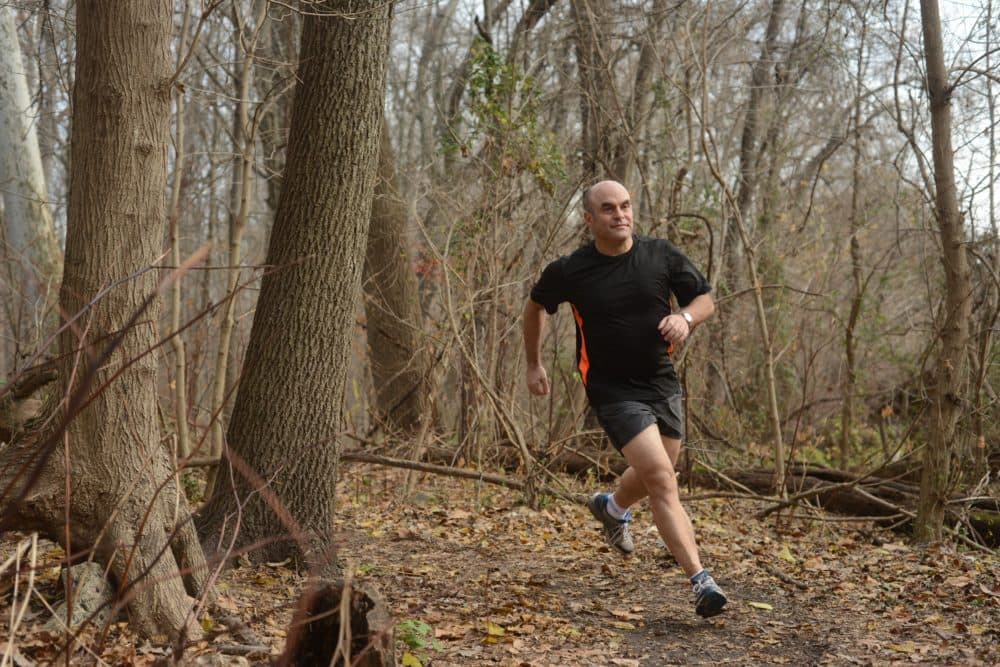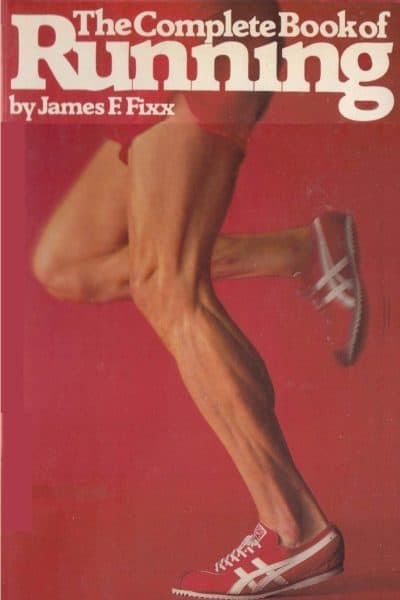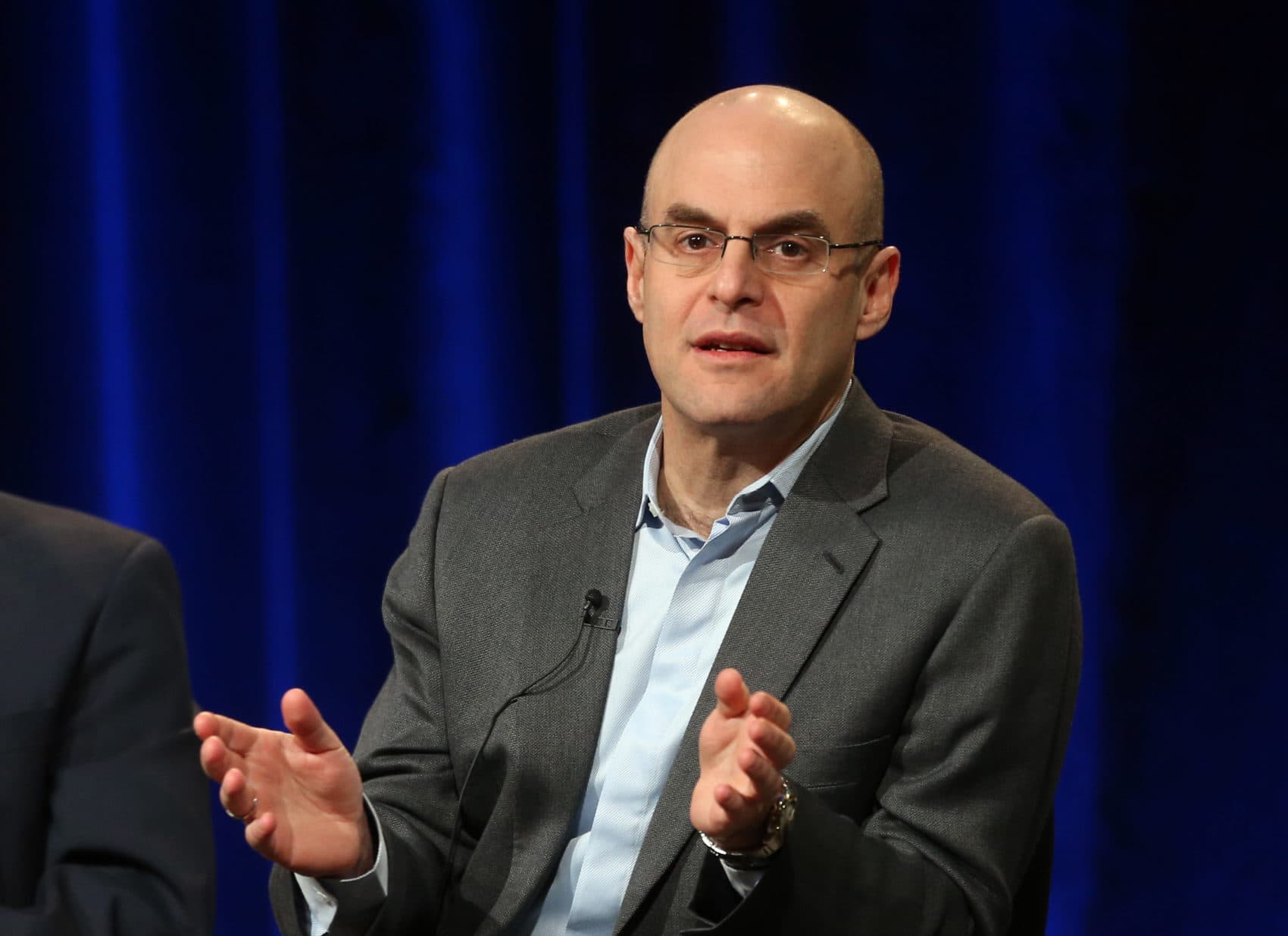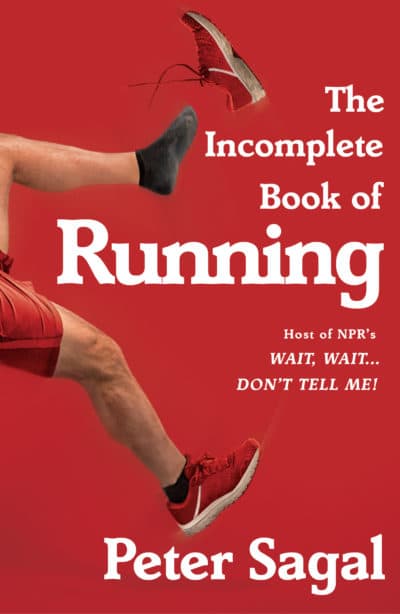Advertisement
Peter Sagal On Running, Male Body Image And His Love Handles
Resume
This story was re-broadcast on September 26, 2020 as part of The Best Of Only A Game.
"I don't think anybody's ever looked at me and said, ‘Woah, that guy's a long-distance runner,’ " Peter Sagal, host of NPR's Wait Wait ... Don't Tell Me!, jokes. "They might say, ‘That guy probably moonlights as a fireplug.’ Or, ‘If that guy was wearing a skirt, he'd look a little bit like a Dalek from Dr. Who.’ I get that."
Peter Sagal has run 14 marathons — one of which he finished in just 3 hours and 9 minutes. That’s a pace of 7 minutes and 16 seconds per mile.
But to get to this point in his running career, Sagal has gone through some dark moments.
'A Pudgy Little Kid'
Before we talk about the period in his life when he says he’d sometimes sneak off to the bathroom in the middle of the day to stare at his “protruding ribs” and hips, when he ran obsessively, when he lost so much weight that his mother took him to the doctor, Peter Sagal wants to make one thing clear.
"You need to say this before you have any conversation about men and body image, which is that women have it a thousand times worse," Sagal says. "Women have been subjected to ridiculous standards of beauty that have changed — much, I'm sure, to their frustration — over centuries. For men, it’s more recent."
Peter Sagal started disliking his own body when he was young.
"For whatever reason, when you're an adolescent, you start comparing yourself unfavorably to the rest of the world," Sagal says. "You start feeling your own insecurities quite vividly. I've never met — I wouldn't trust anybody who was totally happy with themselves as a teenager. I kind of had it bad. And there were a lot of things I didn't like about myself. And one of them was that I was a pudgy little kid who was terribly out of shape."
Sagal was born in 1965 and grew up in suburban New Jersey. His father got caught up in the running boom of the 1970s. He’d wake up early to run before work
"I would laugh at him," Sagal says. "I would make fun of him. I would say, ‘Ah, you went and ran four miles. And where'd you get? Now you're just back here? I've been sitting here eating pancakes, and I think I had the better time. Don't you?’
"I was a snarky — I was destined for my job, even as a young boy, I think."
But as Sagal entered adolescence — and began disliking his body — he started going to his father’s book shelf and pulling down a particular book. It was Jim Fixx’s “The Complete Book Of Running.”

"The cover of the book has, perhaps, the platonic ideal of a runner’s legs in mid stride."
That runner was author Jim Fixx.
"One leg is flexing off the ground, the other sort of coming up next to it — behind it, striding forward," Sagal says. "And the legs are perfect. Thin, lean, muscular — in fact, so muscular you can actually pick out, almost, the tendons and the striations in the muscle. And I remember very vividly taking down that book and looking at that cover, looking at those legs, and looking at my legs, which were — and still are — kind of thick and pudgy. And you couldn't see a muscle to be found."
Sagal says he would flip through the book, taking in the pen-and-ink drawings of very happy-looking people. And when he was 15, Sagal says he made a decision: he realized he couldn’t do any anything about his acne or his social awkwardness.
"But maybe one thing I could do was actually do something about my lack of shape. My lack of fitness, the fact that I was pudgy," Sagal says. "So I asked my father if I could go running with him. And much to his credit, given the mockery that I subjected him to in the prior years, he said yes and invited me — no, he didn't invite me — he woke me up the next morning and took me out for a run.
"And I remember I put on my Keds. I remember they were Keds because that's the brand we all had back in the ’70s. I have this vague memory of them being orange, but I can’t assure you that’s true. And what imprints on memory is trauma, so I really vividly remember trying to follow my father out our suburban street and then up a mild hill — and, really, just dying. My lungs were on fire. My head was swimming. We got about a half mile and I said, ‘I'm done. I can't do it.’ And he said, ‘All right, turn around and go home.’ And I turned around and I went home very slowly. And it was miserable."
But the next morning, Sagal put back on his orange shoes.
"I guess it just speaks to my level of dissatisfaction with myself that I was willing to get up and endure it again," he says. "And, of course, because this is an aspect of running that I think is always true — but especially when you're 15 — I improved quite rapidly."
'It Sort Of Dominated My Waking Life'
Sagal says that within a couple months, he was literally running circles around his father. He got obsessive about running. Sagal started racking up six or seven miles every single day.
And he severely restricted his diet.
"I would literally go to the library and read cookbooks," Sagal says. "Because I was so hungry, I needed to do something about food. So I would read about it. I remember watching TV and waiting for food commercials to come on so I could look at the bowl of soup or the can of Dinty Moore Beef Stew or the whatever-it-was. 'Cause that's how hungry I was. It sort of dominated my waking life."
Sagal says he lost about 40 pounds. His mother became worried. She took him to the doctor.
"He was like, ‘Yeah, he's getting a little skinny. It's OK. You running a lot? Seems healthy, no problem,’ " Sagal remembers. "He didn't ask me, like, ‘How much are you eating every day?’ And he didn't ask me, like — maybe the most important question he could've asked me was, like, ‘Do you consider yourself skinny?’
"I think I would've told him that I still thought of myself as fat — or maybe I might've said something to the effect of, ‘Oh, well, if I ate more, then I'd get fat again’ or something like that. Although I was never diagnosed, I think I was anorexic. The attitude was, ‘No, he’s not in trouble.’ ‘Oh, he’s getting in shape.’ ‘Oh, he’s becoming athletic. How wonderful?’ And it doesn’t mean I was suffering any less. I certainly wasn’t very happy at the time."
A Running Break
Sagal says he began eating more his senior year of high school. (It helped that he started dating someone and eating meals with her.) And when he got to college, he was too busy and distracted to obsess about food. He says his running became sporadic. The weight eventually came back.
Years passed. Sagal became a dad, and he started hosting a public radio show that you maybe hear when you forget to change the dial after tuning in to Only A Game.

"Basically, I just became less active and more sedentary," Sagal says. "And one day, I went to the doctor's office for some sort of checkup. And he weighed me, and he was like, ‘All right, 200 pounds. OK.' 200 pounds?! I'm 5-foot-7. That's not good. And I really freaked out. It was almost as if all of that self-loathing from my high school years came back. Like, ‘Oh, my God, you've become the thing that you most feared.’ "
Sagal started running again. This time, he didn’t restrict his diet in a dangerous way. But he wanted to reach a healthier weight.
"And then, as I reached 40 in 2005, I said to myself, ‘You know, I’m gonna turn 40. I guess I should run a marathon. That’s a good thing to do when you turn 40 and you’re afraid of dying.’ "
So Sagal started training for the Chicago Marathon. He says his colleagues put up with his new project.
"I think they probably endured it as sort of a midlife crisis. Sort of this weird thing that I was going and doing," Sagal says. "I think the main problem they endured was, because I was getting up so early to go running every day, I would sometimes get very sleepy in the middle of the afternoon. And that became a problem. Like, ‘Peter, are you all right?’ I'm like, ‘Oh yeah, I'm good. I'm good.’ But, I mean, they've put up with a lot of grief from me over the years. I think this was one of the easiest things they’ve had to put up with."
Off And Running ... Again
Sagal says he had no idea how to train for a marathon. He overdid it, eventually injuring himself. He had to miss a month of training. But on race day, Sagal lined up.
"And it was miserable," Sagal says. "I had the worst time. Because, of course, I hadn't adequately trained. And I remember very vividly — there's sort of a dead spot in mile 19 through 21 of the Chicago Marathon because you're running along a rather desolate area — running alongside the freeway heading down south toward Comiskey Park. And it's a very lonely place. And I remember just feeling so miserable and really wanting to quit. But I said to myself, ‘I've run, you know, 19, 20 miles of a marathon. If I ever want to finish a marathon, I'll have to go back and run 20 miles again just to get to this point. So I might as well finish.’ "
Sagal did. And when he crossed the finish line after 4 hours and 3 minutes, a thought crossed his mind.
"Much to my amazement, instead of saying to myself, ‘Wow, that was great — now I guess I'll go hike in Nepal or something,’ I said, ‘I wonder if I can do that faster.’ "
The Right Motivation
Peter Sagal considers this to be a turning point. His motivation changed: Instead of running to exercise or to lose weight, he started running to improve his time.
"All of a sudden, you’re doing something that is a positive goal rather than a negative goal," Sagal says. "Instead of abasing and erasing yourself, you’re improving yourself."
A year later, Sagal ran his second marathon. He cut 40 minutes off his time and qualified for Boston.
"Doing it wrong is when you’re trying to achieve a standard that’s external to you," Sagal says. "You're trying to be the skinny, fit cover model that you will never be, and you will make yourself insane if you attempt to do it. The healthy way to do it is to start from the position of, ‘How can I be the best version of myself that I can be?’ "
And Sagal says he's come to accept his own body, including his love handles.
"The men of my family were born with love handles. And I know this from looking at my father and looking at my brothers, we will always have them," Sagal says. "I've accepted that I have love handles and that I don't have hair. There's nothing I can do about either."
But while Sagal has worked on accepting his own body, he sees ways in which society is sending more of the wrong messages to men.
"I was watching, because this is one of my enthusiasms, Game of Thrones," Sagal says. "And I was watching a scene with Theon Greyjoy — who is a sniveling character. He is by no means an admirable guy. And yet, when he takes off his shirt, he could've been a professional bodybuilder 30 years ago, because that's just the standard now."
Sagal says back in the ’70s, kids’ Spider-Man costumes were just plastic smocks with a picture of Spider-Man's torso. Now, they come with with faux muscles.

"It’s weird to have an 8- or 9-year-old boy walking around with this fake Arnold Schwarzenegger physique," Sagal says. "But there’s this insane inflation on male body image that we’re all sort of rolling with even as we speak."
So maybe it’s not so surprising that Sagal says men are more likely to talk to him about depression and marital problems — other things he’s been open about — than about their bodies.
"I think it would be a lot easier for guys who have these issues to know that they're — like in a lot of things — they're not entirely alone," Sagal says.
'They're My Legs'
Sagal is doing his part. He’s released his own book about running. And in a nod to Jim Fixx’s “The Complete Book of Running” — the book he used to pull off his father’s shelf — Sagal titled it “The Incomplete Book of Running.”
And he put his own legs on the cover.
"Because they're not Jim Fixx's legs — they never will be, they never could be — but that's the whole point," Sagal says. "In a weird way, you can sort of describe my whole sort of mental and athletic journey from one point to another of wanting to have legs like those legs to writing my own book, putting my own legs on the cover and saying, ‘Yeah, they're my legs. And they're good enough to be on the cover of a book. My book.’ And that's the whole, I think, difference between trying to be something else and trying to be the best practical version of yourself."
This segment aired on March 2, 2019.
